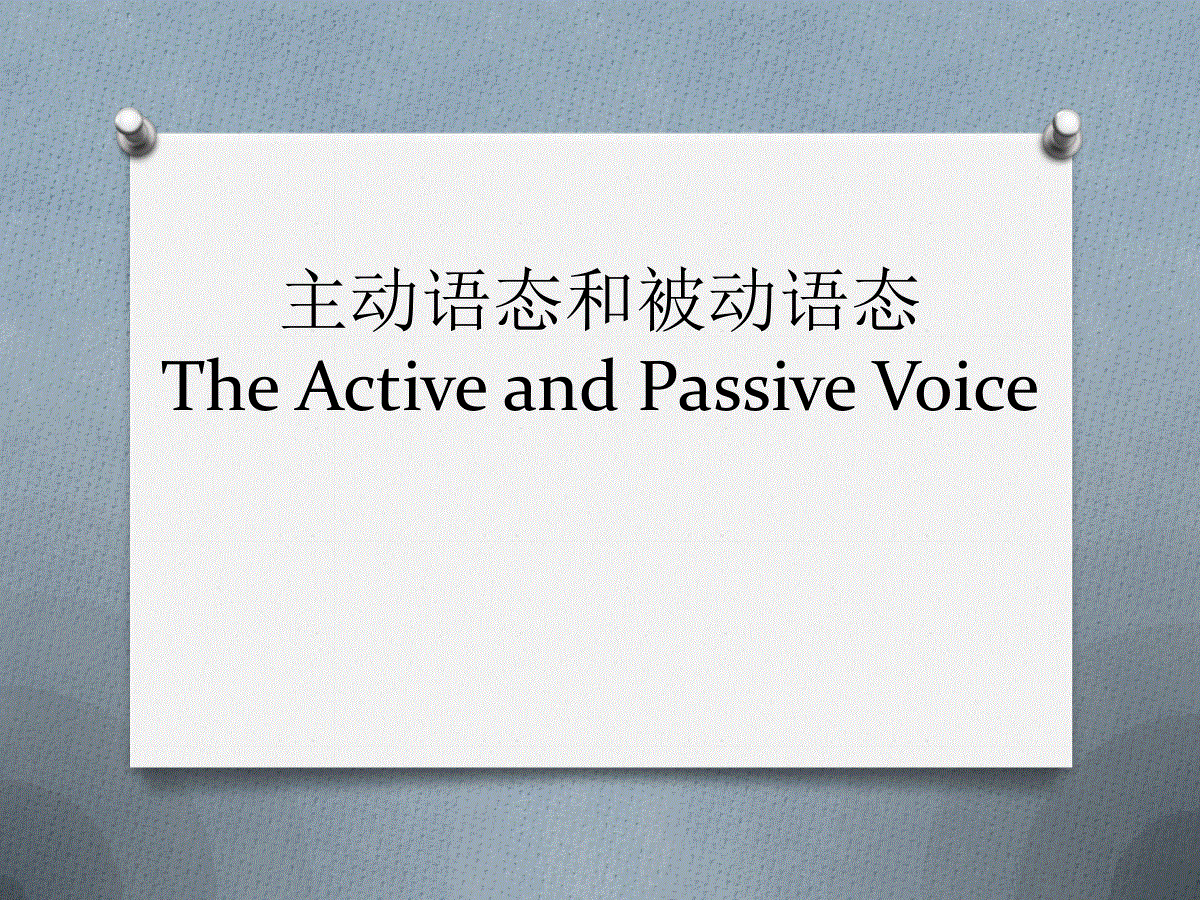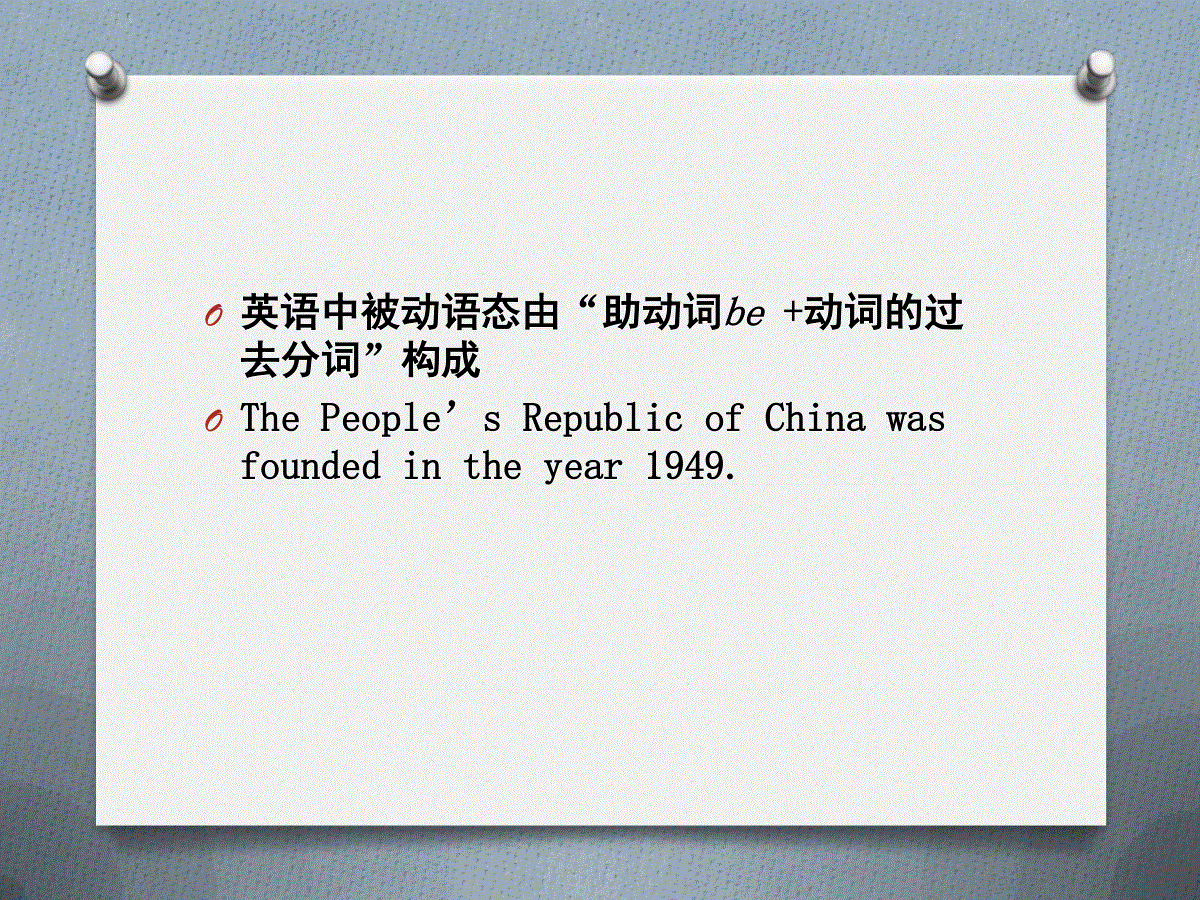当前位置:首页 > 中学教育 > 初中教育 > 英语语法讲解之主动和被动语态
主动语态和被动语态TheActiveandPassiveVoiceWhatisit?O主动语态:O如果主语是动作的执行者(即某人做某事),便叫主动语态。O被动语态:O(1)被动语态定义:被动语态是动词的一种特殊形式,用来说明主语与谓语动词之间的关系。如果主语是动作的承受者(即某事被做),便叫被动语态。O主动与被动的区别不是词序的区别,而是主语与谓语意义上的区别。O在英语中只有及物动词和一些相当于及物动词的词组才有被动语态的形式。O汉语中常用“被”、“给”、“由”、“受”等词用来表示被动。Howdoesitform?O英语中被动语态由“助动词be+动词的过去分词”构成OThePeople’sRepublicofChinawasfoundedintheyear1949.8tenseswhereitiscommonlyusedO(2)英语中被动语态由“助动词be+动词的过去分词”构成。助动词be有时态、人称和数的变化。被动语态后的by短语有时可省去。具体结构见下表:现在时态一般现在时现在进行时一般将来时现在完成时谓语动词构成amis+p.p.areamis+being+p.p.arewill+be+p.p.amis+goingto+be+p.p.arehave(has)+been+p.p.过去时态一般过去时过去进行时过去将来时过去完成时谓语动词构成was+p.p.werewas+being+p.p.werewould+be+p.p.was+goingto+be+p.p.werehad+been+p.p.O[注]p.p.表示过去分词。ExamplesTenseSubjectAuxiliaryPastParticipleSingularPluralPresentThecar/carsisaredesigned.PresentperfectThecar/carshasbeenhavebeendesigned.PastThecar/carswasweredesigned.PastperfectThecar/carshadbeenhadbeendesigned.FutureThecar/carswillbewillbedesigned.FutureperfectThecar/carswillhavebeenwillhavebeendesigned.PresentprogressiveThecar/carsisbeingarebeingdesigned.PastprogressiveThecar/carswasbeingwerebeingdesigned.1.一般现在时:Peoplegrowriceinthesouthofthecountry.Riceisgrowninthesouthofthecountry.Theschooldoesn'tallowustoenterthechemistrylabwithoutateacher.Wearenotallowedtoenterthechemistrylabwithoutateacher.2.一般过去时:Theyagreedonthebuildingofanewcarfactorylastmonth.Thebuildingofanewcarfactorywasagreedonlastmonth.Thestudentsdidn'tforgethislessonseasily.Hislessonswerenoteasilyforgotten.3.一般将来时:Theywillsendcarsabroadbysea.Carswillbesentabroadbysea.Theywillgiveplentyofjobstoschool-leavers.Plentyofjobswillbegiventoschool-leavers.4.过去将来时:Themanagersaidtheywouldcompletetheprojectbytheendoftheyear.Themanagersaidtheprojectwouldbecompletedbytheendoftheyear.Theworkerstoldmetheywouldmendthecarassoonaspossible.Theworkerstoldmethatthecarwouldbemendedassoonaspossible.5.现在进行时:TheradioisbroadcastingEnglishlessons.Englishlessonsarebeingbroadcastontheradio.Wearepaintingtherooms.Theroomsarebeingpainted.6.过去进行时:—Whydidn'ttheydrivethereontime?—Becausetheworkersweremendingtheroad.Becausetheroadwasbeingmended.Thistimelastyearwewereplantingtreeshere.Treeswerebeingplantedherethistimelastyear.7.现在完成时:Someonehastoldmethesportsmeetmightbeputoff.Ihavebeentoldthesportsmeetmightbeputoff.Wehavebroughtdowntheprice.Thepricehasbeenbroughtdown.8.过去完成时:WhenIgottothetheatre,Ifoundtheyhadalreadysoldoutthetickets.WhenIgottothetheatre,Ifoundtheticketshadalreadybeensoldout.Thewholecountrywasverysadatthenewsofhisdeath;Peoplehadconsideredhimtobeagreatleader.Hehadbeenconsideredtobeagreatleader.9.含有情态动词的被动语态:含有情态动词的被动语态是由“情态动词+be+及物动词的过去分词”构成。Youmusthandinyourcompositionsafterclass.Yourcompositionsmustbehandedinafterclass.Hecanwriteagreatmanyletterswiththecomputer.Agreatmanyletterscanbewrittenwiththecomputerbyhim.Whenandhowdoweuseit?O(1)被动语态的用法:O①不知道谁是动作的执行者(即不知道谁做)时用被动语态,省略by短语。如:Amanwaskilledintheaccident./Thiswindowwasbrokenyesterday.O②不说或者众所周知是谁做时,用被动语态,省略by短语。如:Riceisalsogrowninthisplace./Arailroadwillbebuilthereinthreeyears.O③强调动作的承受者,句尾加by短语。如:ItwaswrittenbyLuXun./Apetdogisneverkilledbyitsowner.HowdowechangebetweentheTwoVoices?(2)主动语态如何改写为被动语态:主动句:主语(人/物)+谓语(及物动词)+宾语(人/物)+其他+状语(动作的执行者)(各种时态形式)(动作的承受者)被动句:主语(人/物)+谓语(及物动词)+by+人/物+其他+状语(动作的承受者)(be+过去分词)(动作的执行者)O(3)注意点:O①“动词+间接宾语+直接宾语”改为被动时,可以用间接宾语做被动句的主语。如:OHisteachergavehimadictionary.→Hewasgivenadictionarybyhisteacher.O也可以用直接宾语做被动句的主语,但是需用to或者for引出原句的间接宾语。如:Histeachergavehimadictionary.→Adictionarywasgiventohimbyhisteacher./Hisfathermadehimakite.→Akitewasmadeforhimbyhisfather.O注意:一般在下列动词后,常在间接宾语前用介词to,O如:bring,give,lend,offer,pass,promise,sell,show,teach,tell等。O一般在下列动词后,间接宾语前用介词for,O如:buy,cook,choose,fetch,get,,make,order,等。O②“动词+宾语+动词原形”改为被动时,动词原形前要加to.如:Thebossmadethepoormanwork12hoursaday.→Thepoormanwasmadetowork12hoursaday.O相似动词see,watch,hear,notice,listento,lookat,make,feel,have,letO③“动词+…+介词”改为被动时,介词一般在原位不动。如:Thegirltakesgoodcareofherlittlebrother.→Thegirl’slittlebrotheristakengoodcareofbyher.O常见短语:laughat,operateon,lookafter,makefunof,makeuseoftakecareof,,carryout,,giveup,handin,pointout,putaway,putoff,turndown,workout,talkaboutO④“be+过去分词”未必表示被动语态,而可能是系表结构。如:OHeispleased/worried/tired/…….(系表)(他高兴/焦虑/疲劳……)OHewashit/knockeddown/told/shot/…….(被动)(他被击中/撞倒/关照/射中……)Obedressedin,beseatedin/at/beside/nexttoObeaddictedto,bedeterminedtoObedevotedto,beabsorbedin,bedisappointedat,Obelostin,beengagedin/beoccupiedin,befacedwithEg:1.Sheisseatedonthesofa.2.Addictedtosurfingtheinternet,theboyoftenescapesfromclasses.3.Determinedtogiveupsmoking,hethrewawayhisremainingcigarettes.4.Disappointedatfailinginthemathexam,Kentawouldn’tliketotalkaboutittohisparents.5.Judithlayonthesofa,absorbedinherbook.O⑤当使用see/hear/watchsbdoingsth时,变为被动语态时,doing保持不变。如:OIsawhimgoingintotheshop.(主动)OHewasseengoingintotheshop.(被动)O其他相似情况:Oa,动词+宾语+adjWealwayskeeptheclassroomclean.O→Theclassroomisalwayskeptclean.OOb,动词+宾语+nTheychoseTomcaptain.O→TomwaschosencaptainOc,动词+宾语+donewefoundallourseatsoccupied.O→allourseatswerefoundoccupied.Otherpossibilities用主动表被动Thepicturelooksbeautiful.这里的lo





 三七文档所有资源均是用户自行上传分享,仅供网友学习交流,未经上传用户书面授权,请勿作他用。
三七文档所有资源均是用户自行上传分享,仅供网友学习交流,未经上传用户书面授权,请勿作他用。
 liu85816199
liu85816199
共132篇文档
格式: pptx
大小: 922 KB
时间: 2020-02-20
本文标题:英语语法讲解之主动和被动语态
链接地址:https://www.777doc.com/doc-3918600 .html